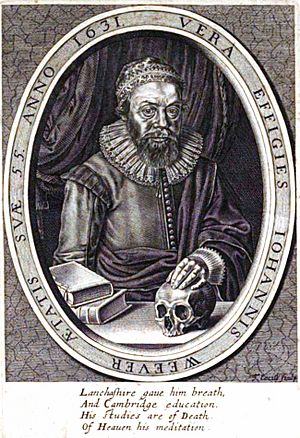John Weever facts for kids
John Weever (born 1576, died 1632) was an English writer and a collector of old things, known as an antiquary. He was also a poet. He is famous for his book Epigrammes in the Oldest Cut, and Newest Fashion (published in 1599). This book contained short, witty poems called epigrams about famous writers like Shakespeare and Ben Jonson. John Weever is also known for his book Ancient Funerall Monuments. This was the first full book about English church monuments and epitaphs (words written on tombs). It came out in 1631, just before he died.
Contents
John Weever's Life
John Weever was born in Preston, Lancashire, England. We don't know much about his early life or who his parents were for sure.
He went to Queens' College, Cambridge, a university, starting in 1594. At Cambridge, he had teachers like William Covell, who was one of the first to mention Shakespeare in print. Another teacher, Robert Pearson, was someone Weever later remembered with thanks. Weever got his degree in 1598. After that, he left Cambridge and moved to London. There, he became very involved in the world of writers and poets.
He traveled to York in 1603 and later visited Lancashire. Eventually, he settled in London. He got married and bought a house in Clerkenwell.
Weever's Writings
In 1599, John Weever published his book Epigrammes in the Oldest Cut, and Newest Fashion. This book had epigrams about many important writers of his time. These included Shakespeare, Samuel Daniel, Michael Drayton, Ben Jonson, and Edmund Spenser. These poems are very helpful for people who study literature today.
The epigram about Shakespeare is special because it uses the same style as Shakespeare's own sonnets. This might mean Weever had seen some of Shakespeare's sonnets even though they were only shared in handwritten copies back then. Many other epigrams were about people Weever knew at Cambridge, so he probably wrote them while he was still a student.
In 1601, a pamphlet called The Whippinge of the Satyre was published without an author's name. This pamphlet criticized three writers of the time. Many people believe John Weever wrote this pamphlet. Because of this, he was then criticized himself in plays by other writers like Thomas Dekker and John Marston. These plays sometimes showed characters who were small and loved tobacco, which Weever himself admitted to being.
Also in 1601, Weever published two more serious books with religious themes: The Mirror of Martyrs and An Agnus Dei. The Mirror of Martyrs was about Sir John Oldcastle. Weever called his book the "first true Oldcastle." This might have been because Shakespeare's famous character Falstaff was first called "Sir John Oldcastle." Weever's book presented Oldcastle as an early Protestant hero. In this long poem, there's a part that reminds readers of Shakespeare's play Julius Caesar. This helps us know when Shakespeare's play was written. Weever's other book from that year, An Agnus Dei, was the story of Christ told in poems. It wasn't very famous for its writing style, but it was printed many times. This might be because it was a tiny book, less than two inches square!
Ancient Funerall Monuments
John Weever showed an interest in tomb monuments as early as his first book in 1599. He spent the next 30 years, from 1600 to 1630, collecting information about monumental inscriptions (words on tombs). He traveled all over England and even visited parts of Scotland, France, the Low Countries (like Belgium and the Netherlands), and Italy.
Back in England, he made friends with other important antiquaries of his time. The result of all his hard work was Ancient Funerall Monuments. This large book was published in 1631.
The book started with a long introduction about funeral monuments around the world. Then, it listed over a thousand inscriptions from four areas in southeast England: Canterbury, Rochester, London, and Norwich. This book is very important because many of these inscriptions have since been lost. Weever saw these inscriptions mainly as old writings. He wasn't very interested in family history or the symbols on the monuments. He also didn't care much about how the monuments looked as sculptures or buildings. He didn't even draw them during his travels. The book itself only has 18 pictures, which were probably added later using drawings from his friends.
Death and Remembrance
John Weever died in early 1632 and was buried at St James, Clerkenwell. A marble plaque with a poem was put up to remember him. This monument was lost when the church was torn down in 1788 to be rebuilt.
The first page of Ancient Funerall Monuments has a picture of Weever. It says he was 55 years old.
Weever's Family Life
Weever's wife was named Anne. We don't know for sure which Anne she was from the old records.


